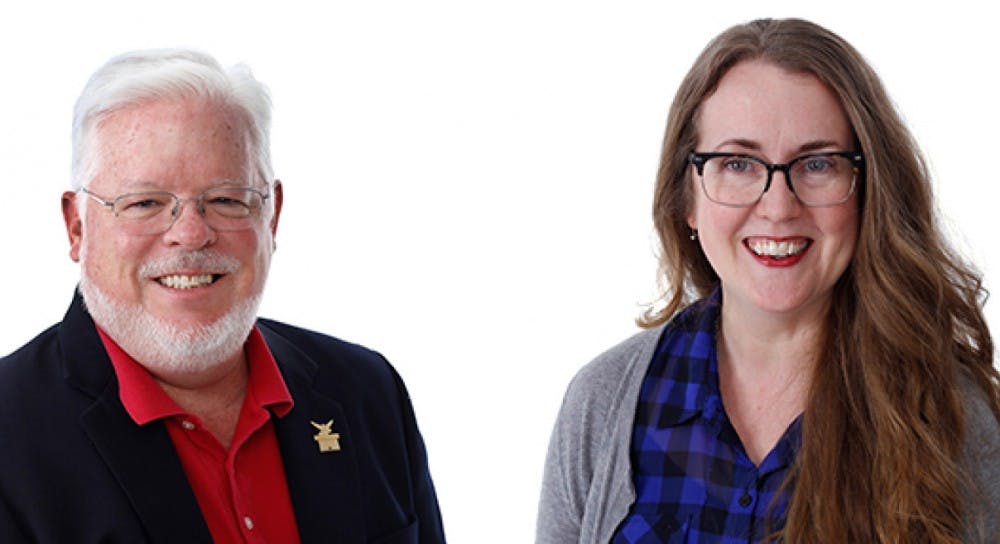Textbooks contain important information that contributes to mastering a subject, class or major, but the authors and the work put into creating the books are not often thought about.
Several professors, like Michael O'Hara, associate dean of the college of fine arts, and Colleen Steffen, lecturer of journalism, however, have first-hand experience in the process of creating textbooks.
For Steffen and O'Hara, the process typically starts with prompting colleagues or an idea and the readiness to delve into the lengthy, unpredictable process. Next, the author must contact a major publishing house and pitch their idea to a representative, who solicits a prospectus, an extensive document that informs what textbooks are available, their purpose, how the new textbook will be different and how the author plans to write the book.
If the prospectus is accepted, the author will be assigned to a developmental editor and the research process formally begins, even though many authors start before the book is even accepted.
O'Hara said he uses the knowledge he has gained from six years of schooling and continued research within his field by reading and writing scholarly journals, staying involved in four professional associations for higher education theater, reading other textbooks and holding his role as president of the International Shaw Society.
From start to finish, developing a textbook can take years. Traditional printed books typically take three years, but online textbooks that have interactive features, including manipulable graphs, videos, html codes and pop-up flashcards, can take much longer.
O'Hara's all-electronic textbook “Explore Theatre” was published in 2012, 10 years after his proposal.
Despite the timeframe, the success of the book inspired him to create a second edition, which was released after only three years of work.
The textbooks are introduction books aimed towards non-major students interested in the theater world and aim to help students gain a basic understanding of its components.
“I try to imagine something I know very well being understood by someone who doesn’t know it at all, or very little,” O'Hara said. “It’s almost like an acting exercise, to sort of crawl into the mind of a student who got dragged to this class. So it’s about what can I say to that kid, that will be interesting to them so that I don’t bore them.”
Both online editions are unique compared to others on the market because part of the book was formed through research that O'Hara conducted by commissioning an original play of 80 students and documented its process from beginning to end.
In full, the books contain more than 14 hours of video content.
“The philosophical stance of the book is that [teachers] aren’t telling you about theater, theater people are telling you about theater,” O'Hara said. “Actors, designers, directors are actually talking to the student. We videoed and interviewed hundreds of them.”
O'Hara also said that students who participated in the play provided a peer-to-peer learning environment where “students who love theater were sharing their love of theater with other students.”
Not only did O'Hara utilize students for creating the videos, but he also sent out surveys to see how they would react to the information provided and the organization of it.
The biggest challenge of writing both textbooks was getting and paying for permission to include graphics and videos that were not created by O'Hara. He said he has four thick, three-ring binders filled with more than 2,000 permission slips that allow him to use different only 17 seconds of a professional theater production, which costs $25,000, and other outside resources in his book.
In order to keep the film in the book, O'Hara partnered with Ball State, who now gets half of all royalties from providing him an internal grant. All of the revenue from royalties is channelled back into the theater program.
Steffen, however, has yet to experience what it is like to have a published textbook and how students will react to it. Her 35-chapter book, which has yet to be titled, is scheduled to print by Sept. 1.
She said she jumped at the opportunity to write the book because she noticed a hole in other textbooks where the emotional content of a reporter’s job isn’t mentioned and keeps students from feeling confident in the field.
“A lot of the textbooks for beginning reporters cover the stuff that’s easily quantified, like types of questions or types of sourcing,” Steffen said. “I’m noticing that in my classes, a lot of the problems that reporters come to me with are not easily quantified, like getting frazzled in the middle of an interview with an important person or ‘I want to be a reporter but talking to strangers makes me sweat.’ It was the emotional stuff, the soft skills. The weird thing about being a reporter is that a lot of it is emotional intelligence: understanding people, how they behave and understand yourself as a human with feelings.”
Throughout the textbook, Steffen is working to create a unique tone by incorporating humor throughout the book, including slang, acronyms, doodles of news graphics and unconventional texts to create a “youthful and casual” voice that is engaging to her readers.
Steffen said she dedicates each week to writing one to two chapters and brainstorming about additional resources that may need included in the book like practice exercises, quizzes, take-away bullet point lists and supplemental websites.
“This is a childhood dream of mine,” Steffen said. “I wrote for newspapers for years, I’ve freelanced and done magazines. I’ve been lucky to make my living as a writer. I still have that second grade dream to have my book on the library shelf. This is a big deal for me, it’s really exciting.”
Contact Melissa Kraman with comments at mmkraman@bsu.edu or on Twitter @missy_kraman.





